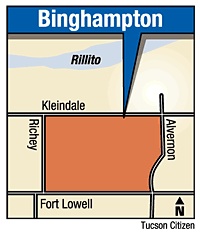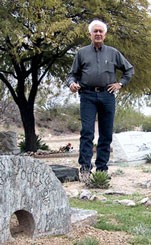

Binghampton: Tucson's Mormon Community
As Tucsonans, we tread over layers of villages that blossomed, flourished and then faded here during five eras extending back 4,000 years. A more recent example of the evolution of communities is still with us - though invisible as such except to old-timers who remember "how it used to be." The community was Binghampton. Though you may not be familiar with it, if you've lived here any length of time, chances are good you've driven through it. Bounded roughly by Kleindale Road on the north, Fort Lowell Road on the south, Richey Boulevard on the west and Alvernon Way on the east, it got its start in 1916. A Mormon community leader, Heber Farr, bought 60 acres south of the Rillito and west of Alvernon, divided them into 12 blocks of four lots each and sold them to other church members for $125 each. Irrigation canals were dug, and the farms soon produced an abundance of fruits and vegetables while domestic animals supplied milk and meat. Binghampton grew, as a satellite community to the Old Pueblo, seven miles distant, to include more than 400 residents. The family that lent its name to the village, and the core around which it grew, had arrived on the scene more than 20 years earlier from Utah via Colorado. What would become Binghampton had its beginnings in 1893 with Erastus Bingham Jr., a veteran of the famed Mormon Battalion in 1846. "The first place they went was to Vail, the Empire Ranch," said Duane Bingham, 66, Erastus' great-grandson, a Tucson real estate broker. "They worked there for a while, doing ranch work, and eventually went over to Congress Street and Fourth Avenue and operated a small dairy there - the same thing they did in Colorado." He soon was providing the Old Pueblo with a welcome commodity: ice cream. |
|
Unlike other Mormons, sent forth by the church to "colonize" a new locale, Bingham had moved here on his own accord after living in Ogden, Utah; Mancos, Colo.; and briefly in Kenilworth, near Florence. In 1897, he moved north of the Rillito near its intersection with Dodge Boulevard, leasing a farming area from Alexander Davidson, a former schoolteacher. There, Bingham grew sugar cane, from which he produced molasses. He was joined by son Daniel in 1898, and a year later by his eldest son, Nephi. Daniel and Nephi had worked as freighters starting in 1883, operating out of Silver City, N.M., hauling supplies to Fort Bowie in southern Arizona and ore from area mines. |
This is a photo of Mormon families
attending church services at Davidson School (original room
was wood, add-on was mud-adobe) around 1916. Mormons also
used the school as a community meeting hall. |
 |
Here, they established a freighting company in partnership with James McGee, carrying pipe and building materials from the rail depot to Greaterville, where gold mining operations were booming. The Binghams and their wives and offspring numbered more than two dozen individuals. Nephi's father was in poor health, and he became leader of the family enterprises. "They hired some Yaquis and some Mexicans and dug a ditch from where Craycroft is on the right side of the river," said Duane Bingham, whose grandfather, Jacob, was Nephi's younger brother.
|
"There was a natural spring up there, and they dug the ditch all the way down to Dodge for irrigation. When they hit low spots, they built redwood flumes." Two ponds, large enough for boats and rafts, were dug north of River Road to store water to feed the irrigation ditches and to provide swimming and recreation. While the Binghams still lived north of the Rillito, they built the original Davidson School (not the one standing now, which is the second), a small adobe structure that also served for church services and as a community meeting hall. Once the families had moved south of the river, Nephi Bingham saw to it that a new school was built, with land donated by Davidson and materials and glass donated by his good friend Charles Bayless, vice president of Consolidated National Bank of Arizona. The community had a surge of population in December of 1909 when eight wagonloads of Mormon refugees arrived after having been expelled from Mexico. |
 This is Duane Bingham, Tucson real estate broker, whose grandfather, Jacob Bingham, was among the founders of a Mormon community here. He is shown in Binghampton Cemetery, a nonprofit Mormon cemetery west of Alvernon Way and north of Fort Lowell Road |
When President Porfirio Diaz - who had encouraged the formation of several colonies of Mormons in Chihuahua - fled to France during the revolutionary period, the Mormons were ordered out of the country with little more than the clothing and bedding they could carry. They were welcomed by the community here and put up in temporary, wood-framed "tent houses" until more permanent structures could be built. Nephi Bingham died in a wagon accident in 1916 at age 57. As the community grew, the need for a permanent place of worship was recognized, and the existing Mormon church at 3700 E. Fort Lowell Road was begun in 1927. A large swimming pool was built nearby - becoming the area's second public pool, along with the pool on Wetmore Road. Though the majority of early Binghampton residents were Mormon, other denominations were welcomed over the years. Catholic families arrived from Texas and South Dakota in the 1920s and 1930s, as did Lutherans from Michigan in the 1940s. "My grandfather (Jacob Bingham) started a bus line between Binghampton and Tucson, the first bus line in the northeast area," Duane Bingham said. "With the last bus of the evening, when it was beginning to get dark, they didn't just drop people off in one spot. They took them to their individual houses." Bingham said the community began to lose its identity in the mid-1960s, by which time Tucson had grown to surround it. "The city zoned all that part north of Fort Lowell Road as 'multiple use,' and when somebody would sell a house, a small business might buy it and tear it down. They could put in pretty dirty little businesses with a lot of stuff lying around, and Binghampton kind of lost its flavor, melting into the rest of the town." One thing does remain, however: Binghampton Cemetery, a nonprofit cemetery located north of Fort Lowell just west of Alvernon. The first burial was made there in 1899, and since that time some 1,500 burials have followed. Bingham manages the 40-acre facility, and has seen to it that nearly 90 trees were planted in what once was a relatively barren piece of property at the base of the foothills. Many of those buried there had roots in Binghampton. Sadly, their resting place is one of the few reminders of what once was a green and thriving, cottonwood-shaded farming community. Tucson Citizen Newspaper Monday, February 28, 2005 |
|
